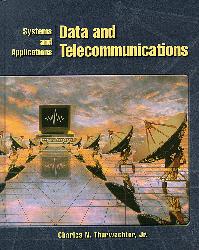
Billed as an in-depth discussion of data communications presented in a way that is “understandable for students who have a limited mathematical background”, Data and Telecommunications covers concepts behind analog and digital communications and the way they have been applied to telecommunications systems and data networks.

Author: Charles N. Thurwachter
Publisher: Prentice Hall
ISBN: 0-13-793910-8
Price: $98 US
Reviewer: Derek Vadala
I have been looking for a book like this for a long time. While TCP/IP, Internet routing and Ethernet are well-covered topics, the telcommunications network that connects the Internet to other data networks, public and private, and to individual organizations and networks is often overlooked.
Many of us use dial-up networking, dedicated circuits (T1, DS3) and DSL on a daily basis, but it's not often that Linux users and system administrators are exposed to the physical or network layers of telecommunications systems. In fact, we're often forced to rely on ISP help desks and specialized phone company personnel who rarely grasp the big picture and are armed with only troubleshooting checklists. This book would make a good reference for any hobbyist or professional who needs to understand these technologies on a more fundamental level, although it might not be the best choice for casual readers.
Billed as an in-depth discussion of data communications presented in a way that is “understandable for students who have a limited mathematical background”, Data and Telecommunications covers concepts behind analog and digital communications and the way they have been applied to telecommunications systems and data networks. Thurwachter begins with a concise introduction to the topic, after which he covers electromagnetic signals, metallic (copper) and optical (fiber) media and antennas. These chapters, like most of the book, take an academic approach to their topics. Because of this, I think many readers will find the book a bit inaccessible.
After covering the basics, Thurwachter launches into a fairly academic discussion of signal and fourier analysis, and amplitude, angle and pulse modulation and demodulation. Although the book prides itself on non-mathematical discussions of the topic, I found that mathematical concepts had not been replaced with thorough real-world analogies and clear high-level explanations.
Chapter 11 (multiplexing) will likely have the biggest appeal to readers who come from UNIX and TCP/IP-based networking backgrounds. It covers channelized T1 and DS3 circuits, as well as signaling associated with these circuits. Thurwachter follows with coverage of error correction and digital modulation.
Chapters 14 and 15 attempt to cover the OSI model and networking hardware. These chapters are better covered by Tannenbaum and Stevens and are clearly written for an audience without any networking experience. Chapter 16 on telecommunications thoroughly covers the details of phone-switching equipment and call routing, but it lacks a practical discussion of the topic. For example, in a discussion of 2-wire vs. 4-wire circuits, no mention of T1 being a common 4-wire circuit is made, despite the fact that it is a widely deployed communication link.
The book finishes with a brief discussion of networking protocols, but like earlier chapters, this topic is covered more thoroughly and with better clarity in other texts. While there is some good information in Data and Telecommunications, it's hard to find it in the middle of a book meant for students. Because of its hefty price, this book probably won't make a good addition to home libraries. But since it does contain some useful, hard-to-find information, I'd recommend buying a copy for the office and passing it around.